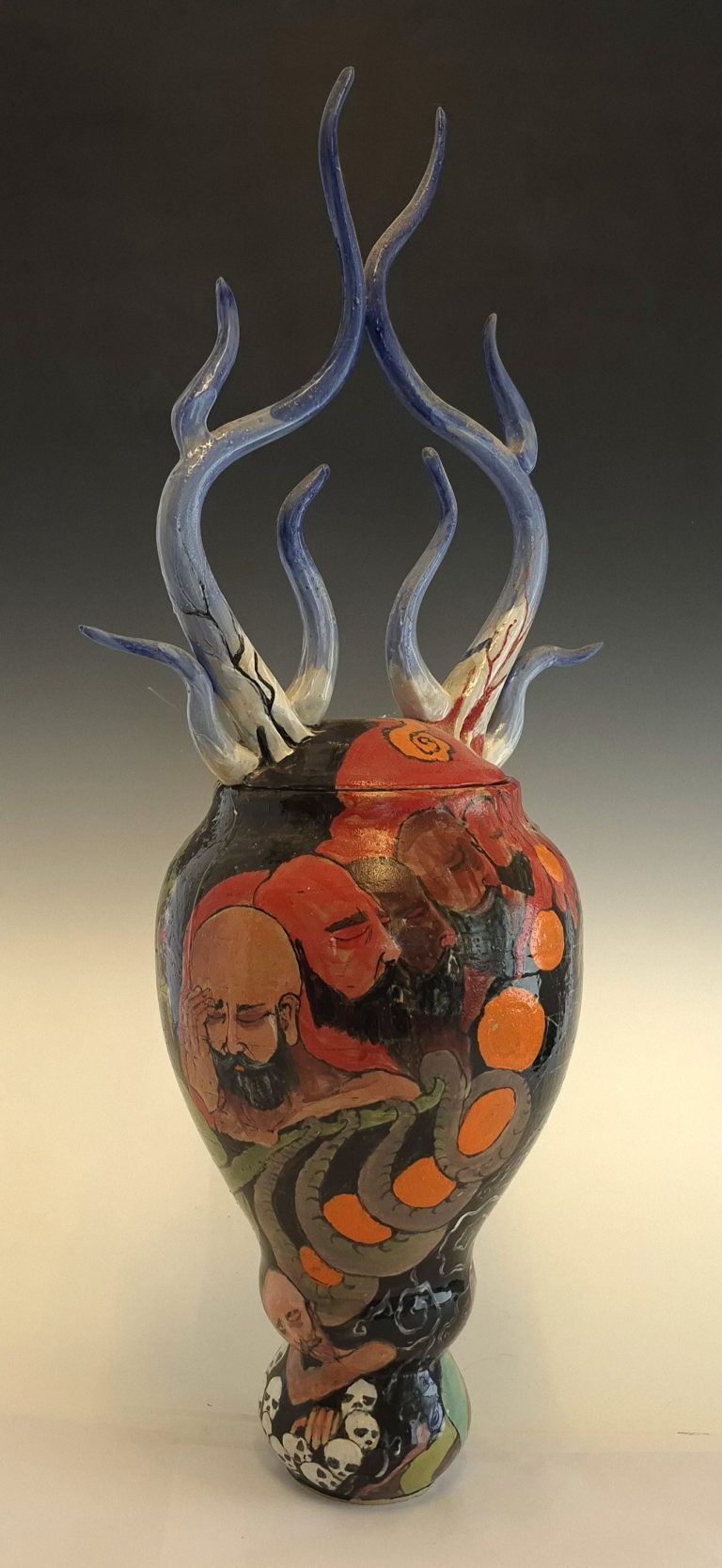Contemporary ceramic artists are no longer confined to the traditional role of creating functional vessels or decorative objects. Today’s clay artists are reshaping the narrative of ceramics, pushing boundaries both technically and conceptually. Their work is more than craft; it is commentary, resistance, and sometimes even an act of creating sanctuaries within a chaotic world.
Clay, one of the oldest materials used by humanity, is at once grounding and radical. It has been with us since ancient civilizations first formed pottery for survival, yet in the hands of contemporary ceramic artists, it has become a language of societal reflection. These artists are challenging the status quo, reintroducing ancient techniques to modern audiences, and even reimagining clay as a medium that can carve out sacred spaces in contemporary life.
Ceramic artists today are breaking the mold—literally and figuratively—and how their work speaks powerfully to the need for balance, reflection, and meaning in the world we live in.

The Evolution of Contemporary Ceramic Artists in Modern Art
To understand the revolution happening in ceramics today with contemporary ceramic artists, it helps to look back at the trajectory of the medium.
For centuries, ceramics were functional: bowls, cups, jars, and tiles. They reflected cultural identity through form and decoration but often remained tethered to utility. By the 20th century, with the rise of the studio pottery movement and artists like Peter Voulkos, ceramics began to be recognized as fine art. The emphasis shifted from function to expression, and clay became a medium of experimentation.
Contemporary ceramic artists build on this legacy. They see clay not just as earth transformed by fire but as a metaphor for resilience, fragility, transformation, and permanence. They break rules—sometimes smashing their own works in process, sometimes leaving rough marks of their hands in the clay, and sometimes building monumental installations that defy the notion of ceramics as small or delicate.
Breaking the Mold: Process as an Artistic Statement
For many ceramic artists, the process is just as important as the final product. In fact, the act of creating often becomes a commentary on societal norms.
Destruction as Creation: Some artists intentionally shatter pieces or fire them in unpredictable ways, highlighting the fragility of human constructs and the inevitability of imperfection. This process becomes symbolic of breaking free from rigid expectations and embracing authenticity.
Sustainability and Raw Materials: Others choose to dig their own clay or use natural glazes, challenging mass-production culture. By slowing down and working directly with the earth, these artists make a statement against consumerism and fast culture.
Collaboration with Nature: Some allow natural elements—like water, erosion, or fire—to finish their works. This surrender of control speaks to larger societal issues, like the climate crisis, and reflects on humanity’s need to reconnect with the natural world.
The process becomes a radical act in itself. It is not about perfection but about authenticity. By breaking away from polished, mass-produced aesthetics, contemporary ceramic artists call attention to the value of the handmade and the imperfect in a society obsessed with speed, consumption, and artificial perfection.

Ancient Ceramic Techniques in Contemporary Sculpture
One of the most fascinating aspects of contemporary ceramics is how artists weave ancient techniques into their modern practice.
-
Coil Building and Hand-Building: Long before potter’s wheels, coil-building was used to construct massive vessels and sacred objects. Many artists revisit these hand-building methods, not just as a stylistic choice but as a conscious connection to human history.
-
Wood Firing: The use of traditional wood-fired kilns connects today’s artists to centuries-old firing practices. The unpredictable patterns of ash and flame create surfaces that cannot be replicated by modern technology, symbolizing both impermanence and timelessness.
-
Ritual and Symbolism: Ancient societies often imbued their ceramics with spiritual or ritualistic significance. Contemporary ceramic artists are tapping into this lineage, embedding their works with symbols of memory, spirituality, and connection to the divine.
By reintroducing these techniques, ceramic artists bridge past and present. They remind us that while technology advances rapidly, there is timeless wisdom in the slow, tactile, and sacred processes of the old ways.
Contemporary Ceramic Artists as Social Commentators
Contemporary ceramic artists are not only concerned with material and technique. Their works also serve as sharp reflections of the world we live in.
-
Politics and Identity: Many ceramicists use clay to explore questions of identity, gender, race, and politics. Clay, as earth, becomes a metaphor for belonging—shaped by human hands, but ultimately universal.
-
Consumerism and Excess: Some artists exaggerate traditional ceramic forms to mock consumer culture, creating oversized vessels or distorted tableware that highlight our relationship with consumption.
-
Fragility of Society: Clay cracks, warps, and sometimes collapses. Artists intentionally use these “flaws” to represent the instability of modern systems—political, economic, or cultural.
Clay’s inherent fragility and strength make it the perfect medium for examining the delicate balance of modern life.
Finding the Sacred in the Contemporary World
Perhaps the most powerful statement contemporary ceramic artists are making is about sacredness. In a world of busyness, technology, and constant distraction, the act of creating sacred spaces through art is revolutionary.
Some ceramic works are designed not simply as objects but as environments. Large-scale installations, monumental forms, or even quiet, minimal vessels can create a space that encourages pause, contemplation, and connection.
This approach carries an important message: the sacred is not lost in the modern world—it simply needs to be remembered.
Clay, as a medium, is grounding. It comes from the earth. It passes through fire. It carries both fragility and permanence. When artists use clay to construct sacred spaces, they remind us of the deeper rhythms of life, the cycles of nature, and the need to step away from noise in order to reconnect with meaning.
These works are not escapist—they do not deny the complexity of modern life. Instead, they carve out sanctuaries within it, showing that sacredness can exist in contemporary spaces if we are willing to recognize it.
Why Contemporary Ceramic Artists Are Redefining Modern Art
While the field of ceramics is vast and constantly evolving, several trends define the artists making waves today:
-
Monumental Ceramics: Large-scale works that transform spaces into environments rather than simply displaying objects.
-
Hybrid Practices: Ceramics combined with performance, installation, or digital technology, pushing clay into new conceptual territories.
-
Community Engagement: Artists using clay workshops, public installations, and collaborative projects to foster connection and dialogue.
-
Spiritual Resonance: Works that consciously evoke ritual, meditation, and sacredness in the everyday.
These trends highlight how ceramics, once relegated to functional craft, now stand at the forefront of contemporary art conversations.
Why Contemporary Ceramic Artists Matter
At their core, contemporary ceramic artists matter because they remind us of our shared humanity. Clay is universal—it exists under our feet, across cultures, across time. By transforming it, artists are not just creating objects; they are telling stories about who we are and where we are headed.
In a world increasingly dominated by the digital, ceramics bring us back to the tactile. They remind us of slowness, of patience, of imperfection, and of sacredness. They challenge us to rethink our values, question our pace, and rediscover meaning in the simplest of materials.
Conclusion: Remembering the Sacred Through Contemporary Ceramic Art
Contemporary ceramic artists are more than makers of objects. They are visionaries, philosophers, and cultural commentators. Through clay, they confront societal norms, revive ancient wisdom, and construct sacred spaces within the modern world.
Their works encourage us to pause, to reflect, and to see the sacred woven into the fabric of contemporary life. In clay, we find both the oldest of human expressions and the boldest of modern statements—a reminder that even in a noisy, chaotic world, there is room to remember what is truly sacred.

One Response